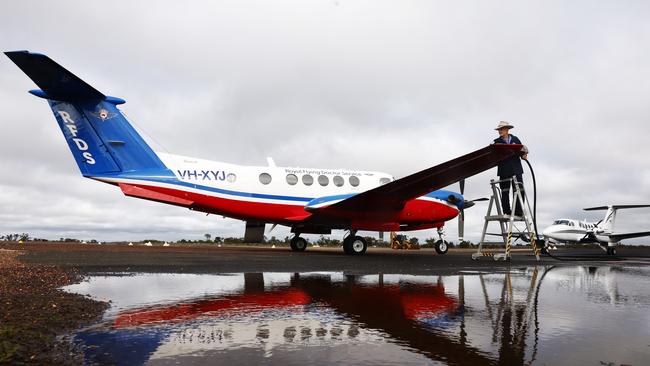NT flights: The solution to delivering remote critical care is in plane sight
A remote medicine expert says the need for new runway infrastructure never goes away.
Business
Don't miss out on the headlines from Business. Followed categories will be added to My News.
Now based in Townsville, Royal Australian College of GPs rural chair, Associate Professor Michael Clements, worked and trained in Katherine between 2007 and 2009 at Tindal, the hospital and in general practice.
Also a pilot, he mainly flew for fun around the town and the communities but has a serious focus on the importance of aviation and medicine in remote Australia and the Northern Territory.
“Nobody appreciates a runway more than somebody that’s clutching their chest in pain in the middle of the night, because I’ve certainly been involved in plenty of situations where I’ve been the doctor on the ground in a small town and when you hear the flying doctor’s plane roar overhead, you get this sense of relief,” he said.
“For many of our remote communities in the Northern Territory, if there isn’t a good runway near them, that isn’t well supported and isn’t graded properly and got the right infrastructure, then people have to wait longer for care – and sometimes that means missing out.

“We must remember that our airports and good quality runways are critical infrastructure.”
While the Royal Flying Doctor Service has been the standard-bearer for remote medical delivery since it first launched in 1928, often it was individual medical aviators who took matters into their own hands.
“The Northern Territory has a good history of doctors who self fly,” Assoc Prof Clements said.
“There was a larrikin former WWII pilot who had his own biplane and started flying out of remote communities in the Northern Territory.
“There’s a great story about him knocking one of his patients on the head when he woke from a drunken stupor and tried to climb out of the plane while they were flying to Darwin.
“There’s always been a very tight connection between aviation and being able to deliver health services to communities that need us the most.”
Fixed-wing aircraft are preferable for the big airports but depending on seasonal conditions, helicopters can be deployed.

“One particular time there was a car accident in Timber Creek and there was just no runway near enough to where the car accident was to be of any use so we had to use a helicopter to get out there and it took a very long time to get out there.
“We know that we need as many all-weather, high-quality runways with things like fuel available to get that care to we need it the most.
“When storms come through in the Northern Territory it does mean that we think twice before taking off in our plane.
“There are good strips around but the RFDS and all the other aviation agencies have got rules on when they can land and if the runway doesn’t have good lighting, if it doesn’t have aerial aids to help them in bad weather or if there’s not good weather reporting for some of those runways then people just can’t get in.
“The more airports we have, the more infrastructure we have that supports aviation, even just for fuel stops, the more we can get out and do more good.
“Even RFDS can’t even get into every strip at every time. If it’s a dirt strip, if it’s not well prepared, if there’s not good lighting, it’s just not going to work.”





